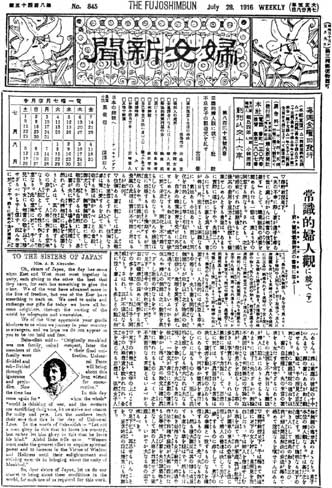
|
Unfurling the Divine Flag in Tokyo:
An Early Bahá'í History
by Barbara R. Sims
| start page | single page | chapter 2 |  |
Chapter 1
Preface
This book is another attempt to record Bahá'í history in the early days of the Faith in the Orient to preserve it for future generations of Bahá'ís. Each time I have written a book, it has been with these future Bahá'ís in mind.The facts are not difficult to write about but to give the times some sort of flavor and give the people mentioned substance does not come easily. When possible I have included a sentence or two concerning the individuals involved that they might seem more real. I was very fortunate to be able to interview a number of the early Bahá'ís of Tokyo. Many of the people mentioned in this book have been friends through the years as I too was a part of the story from December 1953. Nevertheless, in many cases biographical information on the early Bahá'ís is scant or non-existent, and available sources and individual recollections often allow me to give no more than a bare outline of the Bahá'í activities. Still, some sort of record - however sketchy - is better than none.
Generally speaking this book deals with the 1950s and earlier, as Tokyo was the center at that time. After that, the Faith was growing in many different directions, and although Tokyo was still the center, other areas were equally active and important. But that is another story.
I must thank my painstaking assistant, Mr. Hideyasu Takashima, who for many Saturday afternoons searched through various Bahá'í documents in Japanese, Esperanto and Braille, for material I wanted to use.
In the Japanese language all roads are said to ascend (noboru) to Tokyo; roads leading away are said to descend (kudaru). Tokyo is the capital, the hub, the center, the summit of the Japanese nation. Tokyo's position is no doubt partly the cause and partly the effect of the following words of 'Abdu'l-Bahá written in 1914: "Unfurl thou the divine Flag in Tokyo."
History tells us that Tokyo has risen from its ashes many times, the last after World War II. The Faith of Bahá'u'lláh in Tokyo was likewise a casualty of the war, but reborn in its aftermath. Tokyo again bears the divine standard.
1. The First Bahá'í Meeting in Japan, 1909
It was in Tokyo, of course; in 1909, December 27th to be exact.Two American Bahá'ís, Mr. Howard Struven and Mr. C.M. Remey, were making a world trip proclaiming the Faith and Tokyo was their first stop after leaving Hawaii. They were sent on the long trip by 'Abdu'l-Bahá, who advised them to "infuse the fragrance of life into the hearts of the people of Japan."
Professor Barakatullah, an Indian man living in Tokyo, who was a friend of the Bahá'ís, arranged a meeting at which the men could speak. 'Abdu'l-Bahá had asked Mr. Struven and Mr. Remey to meet Professor Barakatullah. He wrote a Tablet May 9, 1909 telling them to convey to Professor Barakatullah His hope that the professor would become the first conqueror of the people of Japan. Barakatullah not only did not heed 'Abdu'l-Bahá's words but he later took the Teachings of the Faith and published them under the name of Islam. His loss.
The meeting which was arranged for Struven and Remey on December 27th was at the old YMCA in downtown Tokyo. It was the largest and most appropriate building in Tokyo at that time. Public notices were sent out in English and Japanese.

click here for larger image
About 75 people assembled: Japanese, Indians, Americans and an English lady. During the six days they were in Tokyo Struven and Remey were invited to speak at various places. One was a luncheon meeting at the home of a friend with fourteen people present. Mrs. Ume Tsuda, founder of a girls' school in Tokyo, entertained them. After spending six days in Tokyo, they went to other cities in Japan and on to China.
In 1914 Dr. George Augur spoke to a group of ministers at the YMCA. Miss Martha Root during her first visit to Japan in 1915 spoke to the English Speaking Club there.
The old YMCA building was destroyed in the Great Kanto Earthquake in 1923 and another building, carrying the same name, was built in its stead. The second building, still standing, has had numerous Bahá'í meetings through the years, being the site of Bahá'í talks by Agnes Alexander, Keith Ransom-Kehler during her visit in 1931, Martha Root in the early prewar days and many talks in the 1950s by Bahá'ís in Tokyo, such as Mrs. Joy Earl and Lt. Col. John McHenry, early American pioneers who were introducing the Faith to the Japanese.

Miss Alexander with her close friends, Mr. Tokujiro Torii and Mrs. Ito Torii. This photo was taken in 1916. Mr. Torii was the fifth Japanese to become a Bahá'í, but the second in Japan. The first three Japanese to become Bahá'ís were immigrants in the United States. The fourth was Mr. Kikutaro Fukuta in Tokyo in 1915.

click here for larger image
One of the earliest printed articles about the Faith in Japan. It was written by Miss Alexander for a women's journal in 1916.
"0 God! The darkness of contention, strife and warfare between the religions, the nations and people has beclouded the horizon of Reality and hidden the heaven of Truth. The world is in need of the light of Guidance. Therefore, 0 God, confer Thy favor, so that the Sun of Reality may illumine the East and the West." (December 30, 1912)
The notebook which contains the original prayer is in Mr. Naruse's archives at Japan Women's College in Mejiro in Tokyo. A photo copy of the original prayer can be found in the book Traces That Remain.
| start page | single page | chapter 2 |  |
|
|